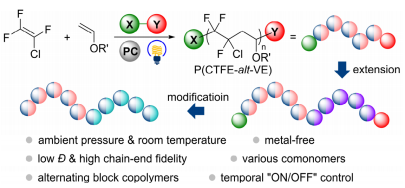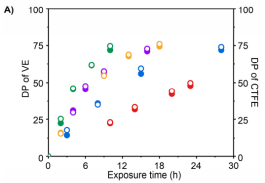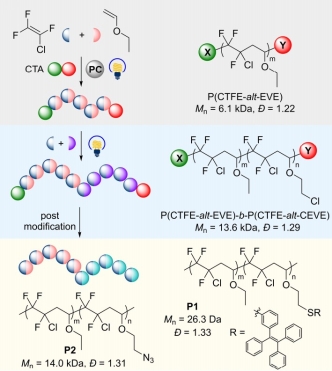 +565 975 658
+565 975 658
 info@premiumcoding.com
info@premiumcoding.com
 Monday - Friday, 8.00 - 20.00
Monday - Friday, 8.00 - 20.00
Fluoropolymers, endowed with outstanding properties such as thermal stability, chemical inertness, excellent weatherability and low surface energy, have found their use in many high-end applications. However, lots of fluorinated homopolymers possess high crystallinity, hindering their processability. Copolymerization is an effective means to regulate the crystallinity and solubility without losing the intrinsic advantages of fluoropolymers. Examples include commercialized products of Halar, Lumiflon and Tefzel, all of which have been synthesized via copolymerization of fluoroethylene and other comonomers. Meanwhile, the incorporation of comonomers enables facile regulation of polymers’ chemical structures and physical properties
While the development of reversible-deactivation radical polymerization (RDRP) has been demonstrated to be particularly effective for acrylates and styrene. the transformation of fluoroethylene (i.e., chlorotrifluoroethylene (CTFE) through a controlled pathway remains a significant challenge. Considerable research efforts have been devoted to synthesize copolymers of CTFE, however, owing to its low boiling point(-26.2 ℃), the synthetic routes typically require high pressure at elevated temperatures (80 to 250 ℃), which limits the broad study of related products. Recently, PolyMao group developed photocatalyzed reversible-deactivation copolymerization to realize precise synthesis of main-chain alternating fluorinated copolymers under ambient conditions, promoting the synthesis of
block alternating fluoropolymers with diverse functional side groups after post modification (Figure 1).

Figure 1. Photoorganocatalyzed reversible-deactivation radical alternating copolymerization of CTFE and VEs
the polymer obtained by this method has controlled molecular weight, narrow molecular weight distribution, high chain-end fidelity and first order kinetics for reactions of different VEs. DPs of both CTFE and VEs are very close to each other throughout the copolymerization processes, confirming the alternating chemical structures of the copolymer backbones (Figure 2). Fluorinated photocatalysts and initiators plays an important role in the process of condition optimization.


Figure 2. Alternating copolymerization of CTFE and vinyl ether (VEs) enabled by the photoredox catalysis. Points of different colors represent results obtained with different VEs: SiBVE (green), EVE (yellow), IBVE (purple), BVE (blue) and CEVE (red). A) Degrees of polymerization (DPs) of CTFE (filled circle) and VEs (empty circle) versus exposure time. B) ln([M]0/[M]t) versus exposure time. [M]0 and [M]t are the concentrations of VEs at time points 0 and t, respectively.
After alternating copolymerization of CTFE and ethyl vinyl ether (EVE), obtained polymer was subsequently employed as a macroinitiator in the chain-extension reaction with CTFE and CEVE under the same photopolymerization conditions without additional photocatalyst. The fluorinated block copolymers with all alternating segments have provided versatile accesses to various fluorinated materials by modifying the chloride group on the side chain. different functionalities could be incorporated, including the azide groups and tetraphenylethylene (TPE). While the tailoring of azide group provides opportunities to further connect with desirable functionalities via the copper catalyzed “click” chemistry (Angew. Chem. Int. Ed. 2001, 40, 2004), the TPE group could embed the corresponding materials with aggregation-induced emission (AIE) behavior (Adv. Mater. 2014, 26, 5429).

Figure 3. Synthesis of block alternating copolymers
The homopolymers and copolymers of chlorotrifluoroethylene (CTFE) have played an important role in many fields and their practical value is self-evident. we expect this method to be useful for creating improved opportunities to tailored fluorinated copolymers under mild condition. Related applications and researches are now undergoing. This work has been published in the J. Am. Chem. Soc. (DOI 10.1021/jacs.0c01016). The authors are Kunming Jiang, Shantao Han, Mingyu Ma, Lu Zhang, Yucheng Zhao, and Mao Chen. See details: https://pubs.acs.org/doi/abs/10.1021/jacs.0c01016
We are welcome for people with interests to contact us for joining our group (summer camp undergraduate, master, PhD or postdoctor).
Email: chenmao@fudan.edu.cn
Get to know us better now!

Wechat:FDUMMers
Search!
Search across our website
Revenant @ 2018 by fudan | All Rights Reserved
Powered by Weicheng

